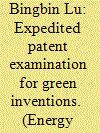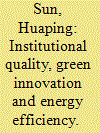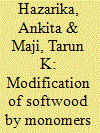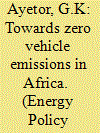|
|
|
Sort Order |
|
|
|
Items / Page
|
|
|
|
|
|
|
| Srl | Item |
| 1 |
ID:
115102


|
|
|
|
|
| Publication |
2012.
|
| Summary/Abstract |
The slow pace of progress in the international climate negotiations is contrasted by the dynamic changes occurring on the ground as competition among countries for green technology leadership heats up. China, Germany, Japan, and the United States all exhibit interest in being green technology leaders although the United States could fall behind due to lack of strong federal government support for climate action.
|
|
|
|
|
|
|
|
|
|
|
|
|
|
|
|
| 2 |
ID:
122893


|
|
|
| 3 |
ID:
130733


|
|
|
|
|
| Publication |
2014.
|
| Summary/Abstract |
Biocomposites can supplement and eventually replace petroleum-based composite materials in several applications. Several critical issues related to bio-fiber surface treatments is to make it a more suitable matrix for composite application and promising techniques need to be solved to design biocomposite of interest. The main motivation for developing biocomposites has been and still is to create a new generation of fiber reinforced plastics material competitive with glass fiber reinforced ones which are environmentally compatible in terms of products, use and renewal. There is an immense opportunity in developing new biobased products, but the real challenge isto design suitable bio-based products through innovation ideas. Green materials are the wave of the future. Bio nano composites have very strong future prospects, though the present low level of production, some deficiency in technology and high cost restrict them from a wide range of applications.
|
|
|
|
|
|
|
|
|
|
|
|
|
|
|
|
| 4 |
ID:
125682


|
|
|
|
|
| Publication |
2013.
|
| Summary/Abstract |
Innovation in green technology is important. Patent rights can provide incentives for green technology research and development. Expedited patent examination for green inventions has emerged as a policy instrument to provide such incentives. Developing countries were never opposed to patents for green technologies. China and Brazil have led the way by offering expedited examinations for green patent applications. More developing countries are expected to follow. Expedited examination for green technologies is consistent with the intellectual property system objectives and is justified by the clear social benefit from green technologies. Introducing such expedited programs in developing countries has sufficient advantages. Existing models of expedited programs for green technologies are analyzed to generalize key issues and to discern suitable policy choices for developing countries. When introducing such programs, a balanced definition for green technology is preferred; a special classification requirement is premature and is not recommended; a pre-examination search requirement is generally recommended to balance patent office workloads, and a green patent database is recommended.
|
|
|
|
|
|
|
|
|
|
|
|
|
|
|
|
| 5 |
ID:
116028


|
|
|
| 6 |
ID:
169866


|
|
|
|
|
| Summary/Abstract |
This paper examines the energy efficiency performance of a sample of 71 developed and developing countries between 1990 and 2014. In most current energy literature, the transition to green technology is seen as a sustainable way to achieve a low-carbon or carbon-free environment. Bearing this in mind, we argue further that adopting green technology needs a strong backing and funding of reliable government institutions to shift the country's paradigm. Considering this issue, we adopt the parametric stochastic frontier approach built on the shepherd distance function to evaluate the effects of both governmental institutions and green technologies on energy efficiency. We find evidence of a significant positive influence of both green innovation and institutional quality on energy efficiency enhancement having controlled for some variables. Regarding energy efficiency levels of the individual countries- USA, Japan, Germany and Australia lead the chart while Belize, Panama, Singapore, Malta, Sierra Leone, Iceland, Jamaica, Bahrain and Ghana are the least energy efficient countries. Policy implications are further discussed.
|
|
|
|
|
|
|
|
|
|
|
|
|
|
|
|
| 7 |
ID:
130735


|
|
|
|
|
| Publication |
2014.
|
| Summary/Abstract |
Technological development of wood polymer composites (WPC) is a very promising approach to overcome most of the disadvantageous properties of wood products, for example their poor mechanical strength, poor dimensional stability, susceptibility to fungal attack, weathering and the like. To find the substitute for costly items of hard wood, suitable technologies have been developed to modify softwood to meet specific end-use requirements. Various vinyl monomers and/or copolymers or thermosetting resin in combination with different types of cross linking agents, flame retarding agents have been used to improve the properties of wood. Nanotechnology is a new area of science and technology which opens up new opportunities to develop wood based products with desired properties. Now-a-days government is making strict legislations to promote green technology for the protection of environment world wide. With the depletion of petroleum resources at alarming rate, it is high time to replace petroleum-based products by some sustainable alternative products based on vegetable biomass. The bio-based resins obtained from renewable feedstock have been widely utilized by taking the advantages of easy availability, renewable nature and low cost. The green route of modification of wood is widely encouraged. With the progress of technological development, now it is possible to avoid the hazardous influence of organic solvents by using water as solvent or diluents formodification of wood. WPC has got tremendous scope for use in diverse areas of applications.
|
|
|
|
|
|
|
|
|
|
|
|
|
|
|
|
| 8 |
ID:
130737


|
|
|
|
|
| Publication |
2014.
|
| Summary/Abstract |
Increasing environmental concern along with the drive to find substitutes for synthetic fibers and value added applications for low cost and renewable plant fibers have led to the development of composites based on biomaterials. One of the drawbacks encountered in such exercise is the lack of adhesion between the incorporated plant fibers and synthetic polymeric matrices. Such drawback can be reduced by appropriate treatment of fibers. This paper describes the chemical treatments used on sponge gourd (Luffa cylindrica) fibers of Brazil to prepare their composites with polyester resin. Production of short fiber-polymer composite as well as mat-polyester composites is presented here. Characterization of the composites in respect of evaluation of density, water absorption, thermalstability, tensile properties and impact strength were made and the results are discussed. Observed impact strengthand tensile properties are discussed based on the fractographic studies of the composites.
|
|
|
|
|
|
|
|
|
|
|
|
|
|
|
|
| 9 |
ID:
177500


|
|
|
|
|
| Summary/Abstract |
This paper reviews vehicle standards in Ghana and other parts of Africa. The paper also considers the cost of ownership of electric vehicles in Ghana. Tesla Model 3, Tesla Model S, Nissan Leaf and Toyota Prius are compared to Toyota Corolla. The parameters considered are initial cost, maintenance cost (spare parts and labour), fuel cost, and availability of skilled labour. Considering Ghana's energy mix, a conventional vehicle will emit 3.35 times more CO2 emissions compared with an electric vehicle. The results show that while there are 30% savings on cost per mile for Toyota Prius it cost at least 13.5% more to own an electric vehicle compared to Toyota Corolla. The Ghana government's tax incentive for removing import levy will only reduce the cost per mile by 2.5%. Ghana's energy surplus of 98.59 GWh is enough to charge at least 1.5 million electric vehicles. But a huge skills gap in electric vehicle maintenance, non-availability of spare parts, charging infrastructure and the initial price of electric cars are the main challenges to overcome to boost electric vehicle penetration in Ghana and other countries in Africa.
|
|
|
|
|
|
|
|
|
|
|
|
|
|
|
|
|
|
|
|
|